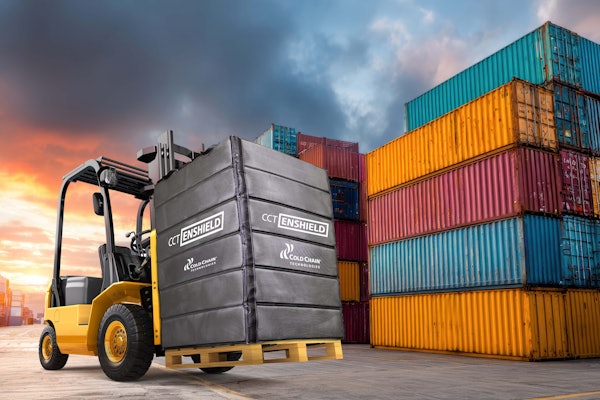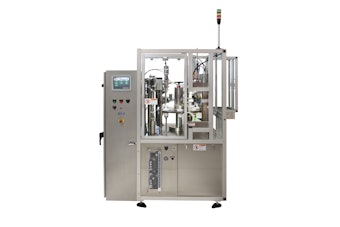In some instances, the plaque grew around the stent. To alleviate the restenosis, Gonzales says, "we added a time-released drug that is sprayed on the stent like a Teflon coating." That drug coating combined with the stent device creates the combination product.
Cordis sells stents worldwide, primarily in North America and Europe. For North America, products are packaged in San German, Puerto Rico; stents sold in Europe are packaged in Juarez, Mexico. Gonzalez confirms that labor costs help make those manufacturing locations attractive.
Workers at both facilities, he says, place products into premade pouches from Perfecseal. Measuring 9¾-in. W x 10¾-in. L, the pouches are nitrogen-flushed to remove oxygen. Foil included in the pouch construction protects against light.
"You can't see the product inside the pouch," says Gonzalez. "The structure is proprietary, and we automatically apply an identification label on one side of the pouch." He says the labels include the Cordis name, product name and code number, and lot number. Label printing is done on-site on pressure-sensitive labels supplied in rollstock from GBS. Labels are printed in about 20 different languages, he estimates. The fourth side of the premade pouches is sealed on a Sencorp bar sealer.
Products made and packaged in Mexico are shipped to Scotland for ethylene oxide (EtO) sterilization. Sterilization of products from Puerto Rico is done in San Angelo, TX. The companies that sterilize the packaged Cordis stents both employ equipment from Steris.
Lessons learned
Packaging combination products, Gonzalez says, is no walk in the park. "When you design a [combination product] package," he says, "you have to keep in mind how you're going to deploy it in the manufacturing area so that it's equipment-friendly for throughput and efficiency. As we go forward with combination products, the challenges revolve around protecting the product more efficiently. It has to be sterile and delivered in as perfect a condition as possible. You have to pick the right material with the right equipment to make seals with integrity to survive temperature fluctuations, and with puncture-resistance to withstand distribution rigors. The aseptic removal of the product from the package in the OR has to be extremely user-friendly so that it can be done without product contamination.
"Combination products pose quite a packaging challenge because we need to find out from scientists what affects the drug, whether it's relative humidity, oxygen, or ultraviolet light," says Gonzalez. "We have to produce the right coextrusion combination for the packaging to protect the product for the end user. And we have to have the packaging equipment to handle the materials." [HCP]
By Jim Butschli, Editor
Cordis sells stents worldwide, primarily in North America and Europe. For North America, products are packaged in San German, Puerto Rico; stents sold in Europe are packaged in Juarez, Mexico. Gonzalez confirms that labor costs help make those manufacturing locations attractive.
Workers at both facilities, he says, place products into premade pouches from Perfecseal. Measuring 9¾-in. W x 10¾-in. L, the pouches are nitrogen-flushed to remove oxygen. Foil included in the pouch construction protects against light.
"You can't see the product inside the pouch," says Gonzalez. "The structure is proprietary, and we automatically apply an identification label on one side of the pouch." He says the labels include the Cordis name, product name and code number, and lot number. Label printing is done on-site on pressure-sensitive labels supplied in rollstock from GBS. Labels are printed in about 20 different languages, he estimates. The fourth side of the premade pouches is sealed on a Sencorp bar sealer.
Products made and packaged in Mexico are shipped to Scotland for ethylene oxide (EtO) sterilization. Sterilization of products from Puerto Rico is done in San Angelo, TX. The companies that sterilize the packaged Cordis stents both employ equipment from Steris.
Lessons learned
Packaging combination products, Gonzalez says, is no walk in the park. "When you design a [combination product] package," he says, "you have to keep in mind how you're going to deploy it in the manufacturing area so that it's equipment-friendly for throughput and efficiency. As we go forward with combination products, the challenges revolve around protecting the product more efficiently. It has to be sterile and delivered in as perfect a condition as possible. You have to pick the right material with the right equipment to make seals with integrity to survive temperature fluctuations, and with puncture-resistance to withstand distribution rigors. The aseptic removal of the product from the package in the OR has to be extremely user-friendly so that it can be done without product contamination.
"Combination products pose quite a packaging challenge because we need to find out from scientists what affects the drug, whether it's relative humidity, oxygen, or ultraviolet light," says Gonzalez. "We have to produce the right coextrusion combination for the packaging to protect the product for the end user. And we have to have the packaging equipment to handle the materials." [HCP]
By Jim Butschli, Editor


















